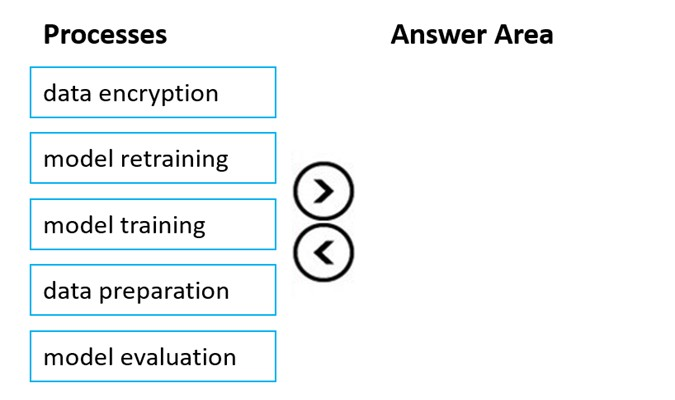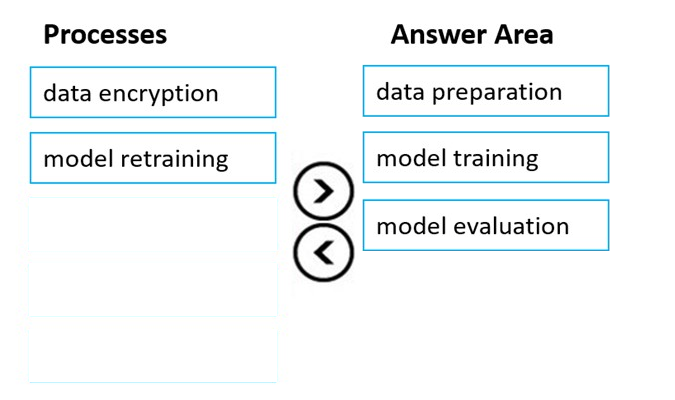Microsoft AI-900 Exam Practice Questions (P. 4)
- Full Access (246 questions)
- One Year of Premium Access
- Access to one million comments
- Seamless ChatGPT Integration
- Ability to download PDF files
- Anki Flashcard files for revision
- No Captcha & No AdSense
- Advanced Exam Configuration
Question #16
You run a charity event that involves posting photos of people wearing sunglasses on Twitter.
You need to ensure that you only retweet photos that meet the following requirements:
✑ Include one or more faces.
✑ Contain at least one person wearing sunglasses.
What should you use to analyze the images?
You need to ensure that you only retweet photos that meet the following requirements:
✑ Include one or more faces.
✑ Contain at least one person wearing sunglasses.
What should you use to analyze the images?
- Athe Verify operation in the Face service
- Bthe Detect operation in the Face serviceMost Voted
- Cthe Describe Image operation in the Computer Vision service
- Dthe Analyze Image operation in the Computer Vision service
Correct Answer:
B
Reference:
https://docs.microsoft.com/en-us/azure/cognitive-services/face/overview
B
Reference:
https://docs.microsoft.com/en-us/azure/cognitive-services/face/overview
send
light_mode
delete
Question #17
When you design an AI system to assess whether loans should be approved, the factors used to make the decision should be explainable.
This is an example of which Microsoft guiding principle for responsible AI?
This is an example of which Microsoft guiding principle for responsible AI?
- AtransparencyMost Voted
- Binclusiveness
- Cfairness
- Dprivacy and security
Correct Answer:
A
Achieving transparency helps the team to understand the data and algorithms used to train the model, what transformation logic was applied to the data, the final model generated, and its associated assets. This information offers insights about how the model was created, which allows it to be reproduced in a transparent way.
Incorrect Answers:
B: Inclusiveness mandates that AI should consider all human races and experiences, and inclusive design practices can help developers to understand and address potential barriers that could unintentionally exclude people. Where possible, speech-to-text, text-to-speech, and visual recognition technology should be used to empower people with hearing, visual, and other impairments.
C: Fairness is a core ethical principle that all humans aim to understand and apply. This principle is even more important when AI systems are being developed.
Key checks and balances need to make sure that the system's decisions don't discriminate or run a gender, race, sexual orientation, or religion bias toward a group or individual.
D: A data holder is obligated to protect the data in an AI system, and privacy and security are an integral part of this system. Personal needs to be secured, and it should be accessed in a way that doesn't compromise an individual's privacy.
Reference:
https://docs.microsoft.com/en-us/azure/cloud-adoption-framework/innovate/best-practices/trusted-ai https://docs.microsoft.com/en-us/azure/cloud-adoption-framework/strategy/responsible-ai
A
Achieving transparency helps the team to understand the data and algorithms used to train the model, what transformation logic was applied to the data, the final model generated, and its associated assets. This information offers insights about how the model was created, which allows it to be reproduced in a transparent way.
Incorrect Answers:
B: Inclusiveness mandates that AI should consider all human races and experiences, and inclusive design practices can help developers to understand and address potential barriers that could unintentionally exclude people. Where possible, speech-to-text, text-to-speech, and visual recognition technology should be used to empower people with hearing, visual, and other impairments.
C: Fairness is a core ethical principle that all humans aim to understand and apply. This principle is even more important when AI systems are being developed.
Key checks and balances need to make sure that the system's decisions don't discriminate or run a gender, race, sexual orientation, or religion bias toward a group or individual.
D: A data holder is obligated to protect the data in an AI system, and privacy and security are an integral part of this system. Personal needs to be secured, and it should be accessed in a way that doesn't compromise an individual's privacy.
Reference:
https://docs.microsoft.com/en-us/azure/cloud-adoption-framework/innovate/best-practices/trusted-ai https://docs.microsoft.com/en-us/azure/cloud-adoption-framework/strategy/responsible-ai
send
light_mode
delete
Question #18
HOTSPOT -
For each of the following statements, select Yes if the statement is true. Otherwise, select No.
NOTE: Each correct selection is worth one point.
Hot Area:

For each of the following statements, select Yes if the statement is true. Otherwise, select No.
NOTE: Each correct selection is worth one point.
Hot Area:

Correct Answer:

Box 1: Yes -
Achieving transparency helps the team to understand the data and algorithms used to train the model, what transformation logic was applied to the data, the final model generated, and its associated assets. This information offers insights about how the model was created, which allows it to be reproduced in a transparent way.
Box 2: No -
A data holder is obligated to protect the data in an AI system, and privacy and security are an integral part of this system. Personal needs to be secured, and it should be accessed in a way that doesn't compromise an individual's privacy.
Box 3: No -
Inclusiveness mandates that AI should consider all human races and experiences, and inclusive design practices can help developers to understand and address potential barriers that could unintentionally exclude people. Where possible, speech-to-text, text-to-speech, and visual recognition technology should be used to empower people with hearing, visual, and other impairments.
Reference:
https://docs.microsoft.com/en-us/azure/cloud-adoption-framework/innovate/best-practices/trusted-ai

Box 1: Yes -
Achieving transparency helps the team to understand the data and algorithms used to train the model, what transformation logic was applied to the data, the final model generated, and its associated assets. This information offers insights about how the model was created, which allows it to be reproduced in a transparent way.
Box 2: No -
A data holder is obligated to protect the data in an AI system, and privacy and security are an integral part of this system. Personal needs to be secured, and it should be accessed in a way that doesn't compromise an individual's privacy.
Box 3: No -
Inclusiveness mandates that AI should consider all human races and experiences, and inclusive design practices can help developers to understand and address potential barriers that could unintentionally exclude people. Where possible, speech-to-text, text-to-speech, and visual recognition technology should be used to empower people with hearing, visual, and other impairments.
Reference:
https://docs.microsoft.com/en-us/azure/cloud-adoption-framework/innovate/best-practices/trusted-ai
send
light_mode
delete
Question #19
DRAG DROP -
Match the principles of responsible AI to appropriate requirements.
To answer, drag the appropriate principles from the column on the left to its requirement on the right. Each principle may be used once, more than once, or not at all. You may need to drag the split bar between panes or scroll to view content.
NOTE: Each correct selection is worth one point.
Select and Place:

Match the principles of responsible AI to appropriate requirements.
To answer, drag the appropriate principles from the column on the left to its requirement on the right. Each principle may be used once, more than once, or not at all. You may need to drag the split bar between panes or scroll to view content.
NOTE: Each correct selection is worth one point.
Select and Place:

Correct Answer:

Reference:
https://docs.microsoft.com/en-us/azure/cloud-adoption-framework/innovate/best-practices/trusted-ai https://docs.microsoft.com/en-us/learn/modules/responsible-ai-principles/4-guiding-principles

Reference:
https://docs.microsoft.com/en-us/azure/cloud-adoption-framework/innovate/best-practices/trusted-ai https://docs.microsoft.com/en-us/learn/modules/responsible-ai-principles/4-guiding-principles
send
light_mode
delete
Question #20
DRAG DROP -
You plan to deploy an Azure Machine Learning model as a service that will be used by client applications.
Which three processes should you perform in sequence before you deploy the model? To answer, move the appropriate processes from the list of processes to the answer area and arrange them in the correct order.
Select and Place:

You plan to deploy an Azure Machine Learning model as a service that will be used by client applications.
Which three processes should you perform in sequence before you deploy the model? To answer, move the appropriate processes from the list of processes to the answer area and arrange them in the correct order.
Select and Place:

Correct Answer:

Reference:
https://docs.microsoft.com/en-us/azure/machine-learning/concept-ml-pipelines

Reference:
https://docs.microsoft.com/en-us/azure/machine-learning/concept-ml-pipelines
send
light_mode
delete
All Pages
